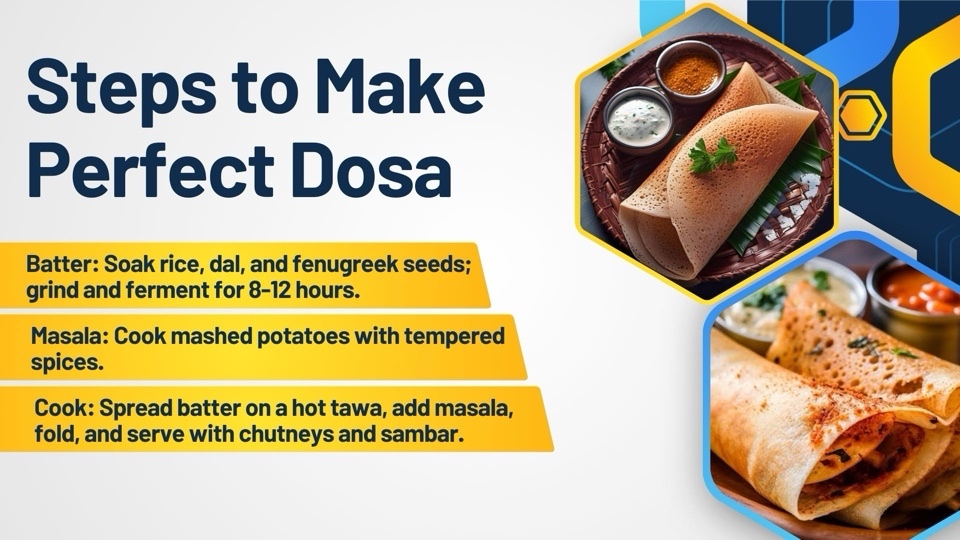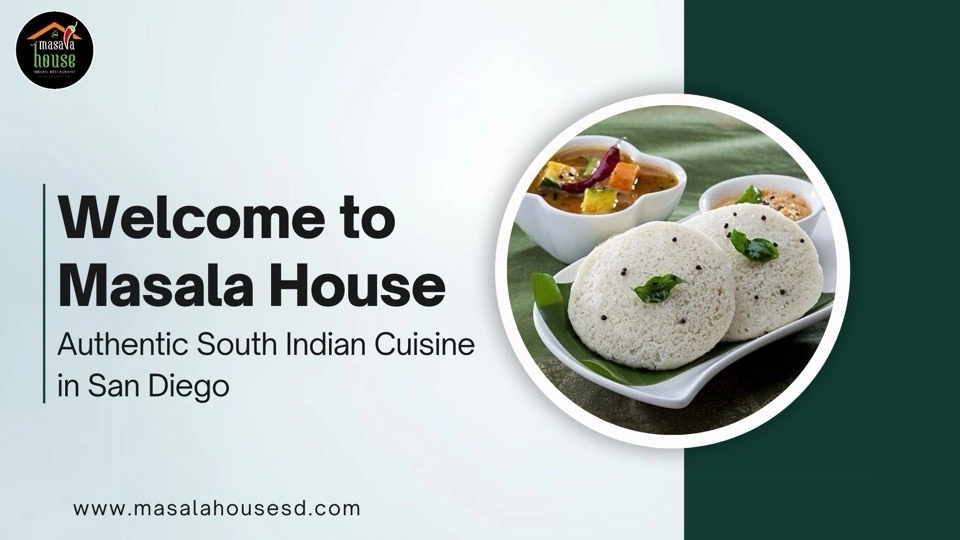A Step-by-Step Guide to Making Perfect Dosa at Home
Dosa, a beloved South Indian dish, is a perfect blend of simplicity and flavor. Its crispy texture, soft interior, and delectable fillings make it a favorite not only in India but across the globe. A dosa, much like a pancake or crepe, is a savory dish made from fermented rice and lentil batter. Its appeal lies in its versatility; it can be served plain or filled with a variety of flavorful ingredients, such as the iconic potato masala.
Whether you’re a seasoned cook or a beginner, learning the art of dosa making at home is a rewarding culinary adventure. This guide will walk you through every step, from preparing the homemade dosa batter to creating the perfect masala dosa recipe. With a little patience and practice, you’ll be able to make restaurant-quality dosa in your own kitchen. Let’s dive into the secrets of this timeless dish.
What is a Dosa?
Dosa is a thin, crispy crepe traditionally made from fermented rice and urad dal (split black gram) batter. Originating in South India, dosa has transcended regional boundaries to become one of India’s most iconic dishes. The dish’s popularity lies in its simplicity and the endless possibilities for customization. While the plain dosa is enjoyed with chutneys and sambar, the masala dosa recipe takes it to another level by adding a spiced potato filling.
Types of Dosa
- Plain Dosa: A simple, unfilled dosa served with chutneys and sambar.
- Masala Dosa: Stuffed with a flavorful potato filling.
- Rava Dosa: Made with semolina instead of fermented batter.
- Cheese Dosa: A modern twist, featuring melted cheese inside.
Why is Dosa So Popular?
- Health Benefits: Low in fat and rich in carbohydrates, dosa is a healthy meal option. The fermentation process also boosts its nutritional value.
- Versatility: Dosa can be adapted to suit various tastes, with endless filling options ranging from classic potato to paneer or even chocolate for kids.
- Ease of Preparation: With a few staple ingredients, dosa can be made at home, making it accessible to everyone.
Mastering dosa may take a few tries, but once you’ve got the hang of it, you’ll find it’s one of the most rewarding dishes to prepare.
Ingredients for the Perfect Dosa
The foundation of a perfect dosa lies in its ingredients. Using high-quality, fresh ingredients not only enhances the flavor but also ensures better fermentation and texture, leading to consistently good results. Here’s a detailed breakdown of what you’ll need for an easy dosa recipe, along with tips for choosing the best ingredients.
For the Batter
- Rice
Parboiled rice is ideal for dosa batter as it provides the right balance of softness and crispiness. You can also experiment with a mix of parboiled and raw rice for a slightly varied texture. The rice contributes to the dosa’s structure and ensures it doesn’t fall apart while cooking.
Tip: Use aged rice for better fermentation and flavor. - Urad Dal
This lentil is crucial for the batter as it adds softness and helps with fermentation. Urad dal makes the dosa pliable and gives it a nice golden hue when cooked. Use whole or split urad dal, depending on availability.
Tip: Always clean the lentils thoroughly before soaking to remove impurities. - Fenugreek Seeds
Fenugreek seeds are a small but mighty addition. They improve the fermentation process and add a subtle, nutty flavor to the batter. Although optional, they are highly recommended for their health benefits and impact on texture.
Tip: Use only a small quantity (about 1/2 tsp) to avoid overpowering the flavor. - Cooked Rice
Adding a small amount of cooked rice to the batter during grinding makes it smoother and helps achieve a perfect consistency. It also contributes to the dosa’s crispiness when cooked. - Salt and Water
These are essential to balance the flavor and adjust the batter’s consistency. Use non-iodized salt for better fermentation, and add water gradually to achieve the desired texture.
Click Here:- The Role of Quality Catering Services in Enhancing Customer Experience at Events
For the Masala Filling
The filling is the soul of a masala dosa recipe, and these ingredients are key to creating the perfect balance of flavor and spice:
- Potatoes
Boiled and mashed potatoes form the base of the filling. Their soft texture pairs beautifully with the crispy dosa. - Onions
Sautéed onions bring out a natural sweetness and enhance the masala’s overall flavor. - Turmeric and Green Chilies
These add color, aroma, and a gentle kick to the filling. - Mustard Seeds and Curry Leaves
Essential for tempering, these ingredients provide an authentic South Indian flavor.
Step 1: Preparing the Homemade Dosa Batter
The batter is the heart and soul of any dosa, and preparing it at home ensures a level of freshness and quality unmatched by store-bought options. While it may seem daunting at first, making the batter is a simple and rewarding process when done correctly. The key is in understanding the importance of each step—soaking, grinding, fermenting, and seasoning.
Soaking
The first step to preparing the perfect batter is soaking the ingredients. This is a crucial process as it softens the rice and lentils, making them easier to grind and ferment. Start by thoroughly washing 2 cups of parboiled rice and 1/2 cup of urad dal (split black gram) under running water to remove any impurities or debris.
Once cleaned, soak the rice and dal separately in water for about 4-6 hours. To the urad dal, add 1/2 teaspoon of fenugreek seeds. These seeds play a dual role: they enhance the fermentation process and add a subtle, nutty flavor to the dosa. Proper soaking is essential as it ensures that the rice and dal grind into a smooth paste, which is critical for the batter’s consistency.
Blending
Once the soaking is complete, it’s time to blend the ingredients. Use a high-speed blender or wet grinder for the best results. Begin by grinding the urad dal and fenugreek seeds into a smooth, fluffy paste, adding water gradually to achieve the right consistency. Next, grind the rice separately, aiming for a slightly coarse texture.
For an even smoother batter, add 1/4 cup of cooked rice while grinding the rice mixture. This small addition not only improves the batter’s consistency but also contributes to a crispier dosa when cooked. Combine the ground rice and dal in a large mixing bowl and mix them thoroughly.
Fermentation
Fermentation is what transforms the batter into a magical base for dosa. Once the batter is mixed, cover the bowl with a lid or a clean kitchen towel and let it sit in a warm place for 8-12 hours. The batter should rise and develop a slightly tangy aroma, indicating successful fermentation.
If the weather is cold, the fermentation process can take longer. To create a warm environment, place the batter in an oven with the light on or near a warm appliance. Properly fermented batter is airy and light, which is essential for making soft yet crispy dosas.
Adding Salt
After fermentation, add salt to taste and mix the batter gently. Avoid overmixing, as it can deflate the batter and affect the dosa’s texture. The batter should have a pancake-like consistency—neither too thick nor too runny.
Step 2: Making the Masala Filling
The masala filling is what turns a plain dosa into the delightful masala dosa. This filling, made with spiced potatoes, adds a burst of flavor and transforms the dish into a wholesome meal.
Boiling the Potatoes
The primary ingredient for the filling is potatoes. Begin by peeling and boiling 4 medium-sized potatoes until they are tender and easy to mash. Once boiled, mash them lightly, leaving a few chunks for texture. This balance of smooth and chunky potatoes makes the filling more satisfying.
Tempering
Tempering is a hallmark of South Indian cuisine and sets the foundation for the masala’s flavor. Heat 1 tablespoon of oil in a pan and add 1 teaspoon of mustard seeds. Let them splutter, releasing their nutty aroma. Add a pinch of asafoetida (hing), a few curry leaves, and 2 finely chopped green chilies. This combination creates a fragrant base for the filling.
Cooking the Filling
Next, add 1 large sliced onion to the pan and sauté until golden brown. The caramelized onions add sweetness that balances the spice from the chilies. Stir in 1/2 teaspoon of turmeric powder, which gives the filling its vibrant yellow color. Finally, add the mashed potatoes and salt to taste. Stir well to ensure the spices coat the potatoes evenly.
Finishing Touches
If the mixture feels too dry, add a splash of water and cook for another 2-3 minutes. The filling should be moist but not watery. Once done, set it aside and let it cool slightly. You can also enhance the filling by adding boiled peas, grated carrots, or crumbled paneer for a twist.
Step 3: Cooking the Dosa
Once your batter and filling are ready, the final step is cooking the dosa itself. This step requires some practice, but with a few tries, you’ll master the art of making perfect dosas at home.
Preheating the Pan
A good dosa starts with a well-heated pan. Use a non-stick or cast-iron tawa (griddle) for the best results. Sprinkle a few drops of water on the pan to test its temperature. If the water sizzles and evaporates immediately, the pan is ready.
Spreading the Batter
Pour a ladleful of batter onto the center of the pan. Using the back of the ladle, spread the batter outward in a circular motion to form a thin, even layer. The thinner the dosa, the crispier it will be.
Cooking the Dosa
Drizzle a few drops of oil or ghee around the edges of the dosa to enhance its flavor and crispiness. Cook the dosa on medium heat until the edges start to lift, and the bottom turns golden brown. Avoid flipping the dosa; it’s traditionally cooked on one side only.
Adding the Filling
Once the dosa is cooked, place a spoonful of the masala filling in the center. Fold the dosa in half or roll it, depending on your preference. Serve immediately with coconut chutney and sambar for an authentic South Indian experience.
Tips for Perfect Dosas
- Season your pan before cooking by rubbing it with an onion slice dipped in oil to prevent sticking.
- Adjust the batter’s thickness by adding water if it becomes too thick during use.
- Practice spreading the batter to achieve even, round dosas.
- Clean the pan with a damp cloth between dosas to remove any residue.
With these steps and tips, you can master the art of dosa making at home and create a dish that’s as delightful as it is satisfying. Enjoy your dosa journey!
Variations of Dosa Recipes
Dosa is a versatile dish, loved for its adaptability to a variety of tastes and preferences. Its base of fermented batter allows for endless possibilities when it comes to flavors, textures, and fillings. From simple classics to indulgent innovations, dosa caters to every palate. Here’s an in-depth look at popular dosa variations inspired by the options available in the reference image:
- Plain Dosa: A simple, crispy crepe served with chutneys and sambar.
- Masala Dosa: A dosa filled with spiced potato masala for a savory treat.
- Cheese Dosa: A dosa topped with melted cheese, perfect for kids and cheese lovers.
- Ghee Masala Dosa: A rich dosa layered with ghee and spiced potato filling.
- Ghee Podi Masala Dosa: Dosa enhanced with ghee and flavorful podi spice mix.
- Onion Dosa: Dosa sprinkled with caramelized onions for a sweet, savory flavor.
- Onion Chili Dosa: Dosa with onions and chilies for a spicy kick.
- Mysore Masala Podi Dosa: A fiery dosa with Mysore chutney, podi, and potato masala.
- Guntur Chili Dosa: A spicy dosa infused with Guntur chili flavors.
- Egg Dosa: Dosa layered with beaten egg for a protein-rich option.
- Cheese Masala Dosa: A cheesy twist on the classic masala dosa.
- Mix Veg Uttapam: A thick dosa topped with mixed vegetables for a hearty meal.
- Tomato Uttapam: A pancake-like dosa topped with juicy tomatoes for added flavor.
Conclusion
Dosa, with its endless variations, offers something for everyone. From the simplicity of a plain dosa to innovative creations like Cheese Masala Dosa and the fiery Guntur Chili Dosa, each version brings a unique flavor and texture to the table. These variations keep the dish exciting and cater to a wide range of preferences, ensuring there’s always something new to enjoy. Whether you’re making dosa at home or looking to try a variety, the options are limitless.If you’re craving authentic dosa, Masala House is the perfect destination to explore these exciting flavors. With a menu that includes everything from classic dosas to creative uttapams, Masala House brings the best of South Indian cuisine to your plate!



